1. Eastern Mud Turtle
If you’re looking for a turtle that stays small and is suitable for a beginner, then the Eastern mud turtle is worth considering. This turtle’s friendly nature, easy-to-please eating habits, tiny size and relatively simple care routine make the Eastern mud turtle a very popular pet.
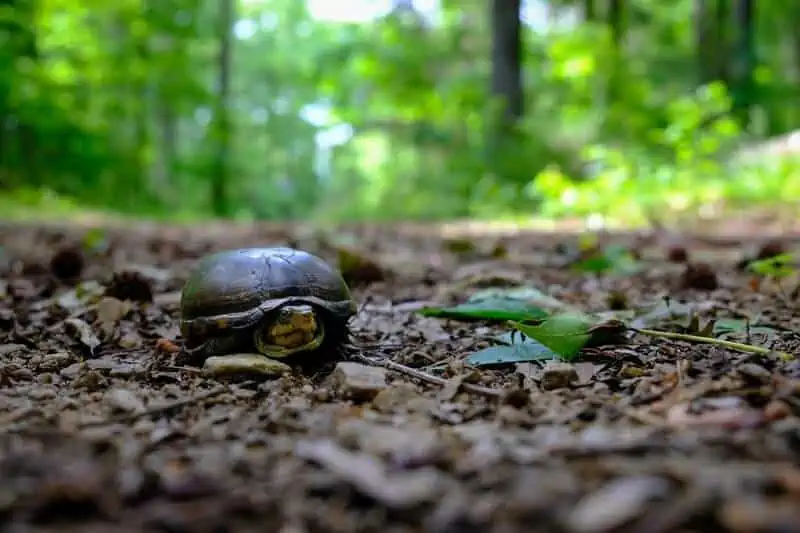
In the wild, these sweet turtles can be found near ponds, streams, lakes and other moist areas where there is plenty of mud and sediment available for burrowing. True to its name, the Eastern mud turtle can be found in eastern states such as Florida, Georgia, Kentucky, Delaware, Maryland, New York and New Jersey. In fact, these turtles make their homes in much of the eastern and southern parts of the United States.
Even though these turtles spend a lot of time burrowed in the mud, they are actually named for the dark brown, mud-like coloration of their spherical shells. A mud turtle’s shell only has 11 plates, making it quite unique in the turtle world.
Housing an Eastern mud turtle is pretty easy if you follow a few basic steps.
These small pet turtles love to swim, so you’ll need to provide them with enough space and water for paddling around the tank. Make sure, however, to provide enhancements that will allow the turtle to easily climb to the surface to breathe. Without something solid to climb on, a mud turtle could drown. Aquatic plants and a soft, mud-like substrate are also important tank enhancements. Keep the water between 75 and 82 degrees Fahrenheit.
As for heating and lighting, an Eastern mud turtle tank should have a UVB light and some type of heating lamp for the basking area.
Eastern mud turtles can be given high quality turtle pellets and a selection of leafy greens. Lettuce or parsley are good options. Food should be dusted with a supplemental vitamin powder about once a week.
- Average Size: Up to 5 inches
- Tank Size: 75 gallon tank
- Average Lifespan: 25-50 years
2. Spotted Turtle
Spotted turtles, native to parts of the eastern United States, are often considered to be good pets. And even better, these turtles will stay small forever! While they require a fair amount of care, a dedicated beginner should be successful. Before taking on the care of a spotted turtle, it’s important to realize that these turtles are a threatened species in the wild. Make sure that you are buying a spotted turtle that was bred in captivity.
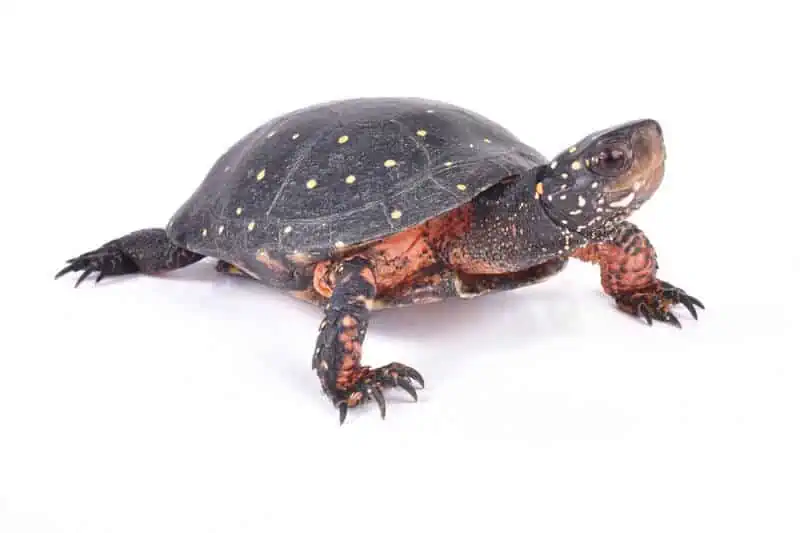
As the name suggests, a spotted turtle does indeed have spots. In fact, its dark brown shell and body are covered in bright yellow spots. Some may display red or orange belly spots as well.
These sweet, friendly turtles need a tank that has a wet and a dry side. For the dry side, provide plenty of places to bask and a soft substrate that is good for burrowing. The wet side of the tank should contain enough clean, filtered water to create a shallow swimming area. We suggest keeping the water in this area slightly acidic, as this will help to keep fungus from growing on the turtle’s skin.
Aquatic plants, sphagnum moss and small logs are excellent additions to a spotted turtle’s habitat.
Turtle pellets are fine to give a spotted turtle in captivity. Leafy greens and fruit should be provided as well, and the occasional snail, worm or piece of cut up fish is totally fine and recommended. Never overfeed a spotted turtle, and a calcium supplement powder should be used once a week.
- Average Size: Males: 3-5 inches, Females: 5-7 inches
- Tank Size: 20-50 gallon tank
- Average Lifespan: 26-50 years
3. Reeve’s Turtle
Reeve’s turtle, also known as the Chinese pond turtle, is a popular pet in countries such as China, Taiwan and Japan. This lively and easy-to-care-for turtle that stays small also benefits from being low-maintenance. While alright for beginners, Reeve’s turtle does have some very specific care requirements.
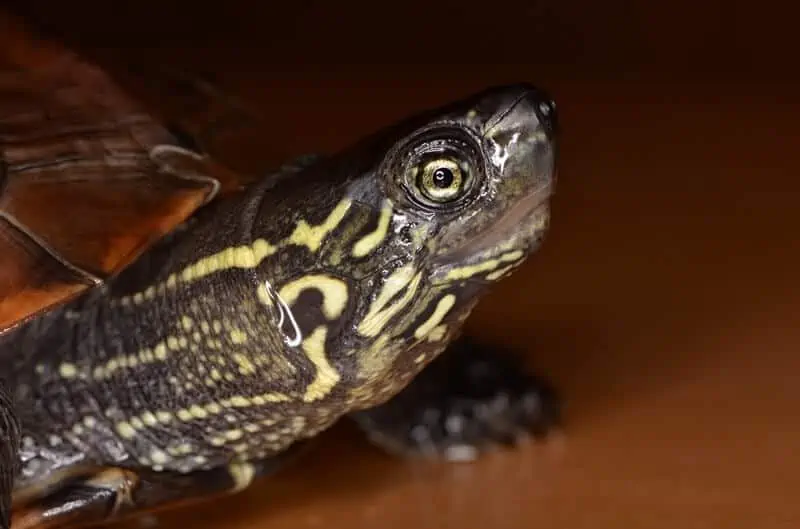
This turtle’s dark brown coloration may not turn heads, but its three longitudinal keels and occasional variations in coloring add interest and individuality.
When setting up a Reeve’s turtle tank, keep in mind that this turtle is not a great swimmer. A good rule of thumb when calculating water depth for the tank is to make the depth no more than one and a half times the length of the turtle’s shell.
The tank will need a basking area, supplemental UVB lighting and a heat lamp placed near the basking spot. Aquatic plants, logs and several turtle hides are tank enhancements that we highly recommend.
A Reeve’s turtle will do very well on a diet of turtle pellets and leafy vegetables, but they will enjoy extra treats like worms, snails and chopped fish.
These little turtle pets can be prone to shell diseases, so it’s very important to inspect the shell on a regular basis.
- Average Size: 4-9 nine inches long
- Tank Size: 50 gallon tank
- Average Lifespan: 10-20 years
4. Diamondback Terrapin Turtle
The diamondback terrapin tends to be larger than the others on this list, but in terms of pet turtles, it’s still considered to be small. Because of its rather complicated care requirements, it is not one that we would recommend for a beginner. However, intermediate to advanced pet owners will find that the diamondback terrapin is well worth the extra care.
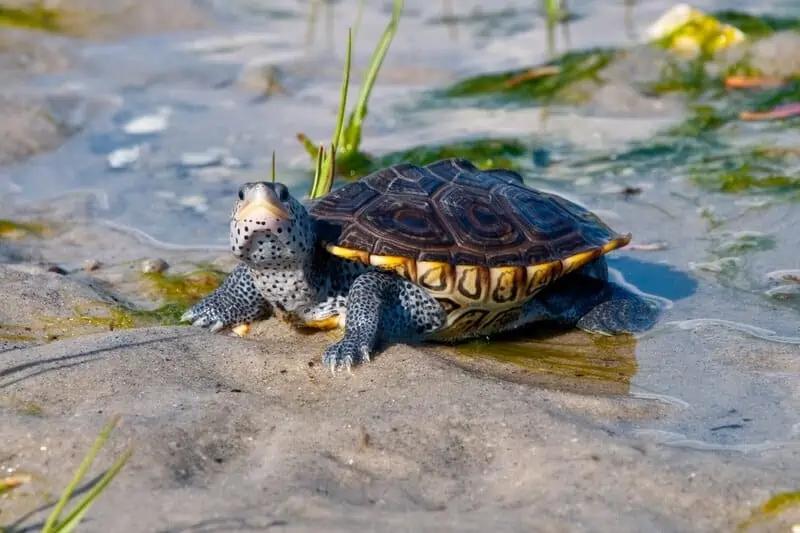
Before you purchase a diamondback terrapin, it’s very important to make sure that owning one is legal where you live. While not endangered, this turtle is protected in some states, and you may need to get a permit to have one.
The diamondback terrapin can be found in states all along the Atlantic and Gulf coasts in wetlands such as mudflats, salt marshes, mangrove swamps, estuaries and lagoons.
Because these turtles are broken down into different subspecies, it’s hard to make a general description. Diamondback terrapin shells come in lots of colors that range from dark brown to gray, and their bodies can be yellow, brown or even white. Unique skin patterns and large feet distinguish diamondback terrapins from other turtles.
Even though this is a turtle that stays small, it still needs a pretty big tank because it loves to explore its surroundings. Provide it with brackish, filtered water that’s at a depth of at least three times the length of the shell, and it will need at least one rock where it can climb out of the water and bask. Crushed coral makes an excellent substrate because diamondbacks love to munch on it.
Other important tank enhancements include some kind of heat lamp, supplemental UVB lighting, aquatic plants and plenty of basking rocks.
Feeding your diamondback terrapin a diet that is mostly turtle pellets is fine, but it’s nice to supplement this diet with crowd favorites like snails, dried shrimp, worms and chopped up fish. After feeding time, remove any uneaten food.
Diamondback terrapins are prone to health issues such as shell rot, parasites, and eye deformities. Some of these issues can become quite serious, so you will need to contact your veterinarian if your turtle seems ill.
- Average Size: Males: 5 inches, Females: 7.5 inches
- Tank Size: 75 gallon tank
- Average Lifespan: 25-40 years
5. Bog Turtle
The bog turtle, also sometimes known as Muhlenberg’s turtle, is the smallest turtle in North America. In the wild, this turtle likes to hang out in the bogs, moist meadows and swampy areas of the eastern United States. These sweet, little turtles are considered to be endangered, so it’s very important that you only buy one from a licensed breeder or from a reputable and trustworthy turtle adoption center.
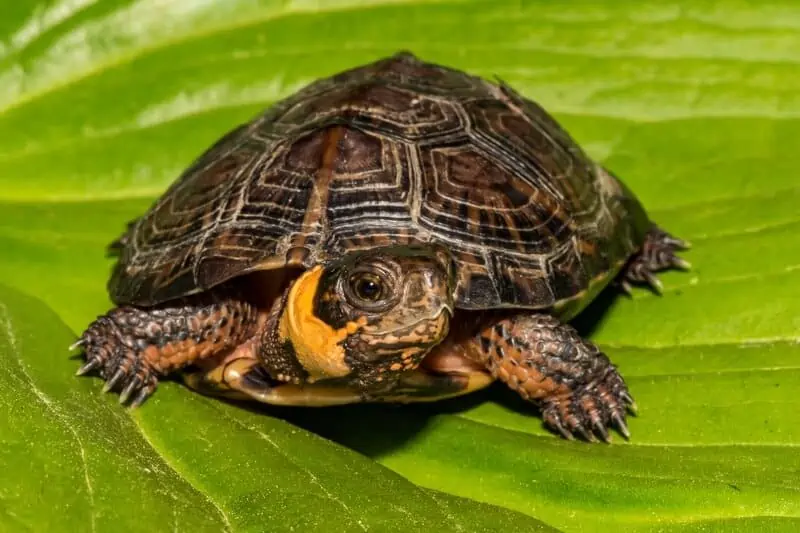
The bog turtle’s elongated shell is a pretty unremarkable, dark brown, but the bright orange or yellow spots on each temple help to distinguish it from other small turtles.
Despite their small size, bog turtles need quite a large tank. In the wild, bog turtles don’t spend all of their time in the water, and that’s why the enclosure that you design should contain both a wet and a dry side. Other important tank enhancements include plenty of places to hide, a soft substrate, real or artificial plants and rocks or logs for basking.
A supplemental UVB basking light and some kind of heat source should also be added to your bog turtle’s enclosure.
Your bog turtle will need a balanced diet that consists of some fruits, leafy greens, seeds and protein like canned dog food, worms, snails and slugs. There are also vitamin supplement powders that can be added to your turtle’s food.
- Average Size: 3-4 inches
- Tank Size: 40 gallon tank
- Average Lifespan: 20-30 years
6. Desert Box Turtle
Desert box turtles are found in the grasslands, prairies and arid areas of Texas, New Mexico and Arizona, and it’s not uncommon to find this turtle hanging out in prairie dog towns.
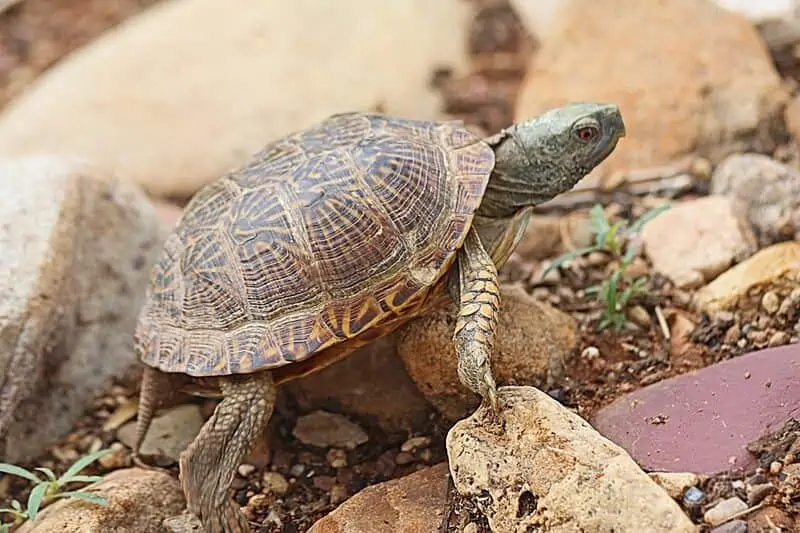
This turtle’s interesting name comes from the fact that when it pulls its head inside its shell, it looks kind of like a box. The shell of the desert box turtle comes in one of two forms. Some shells are found with patterns on them, and some of them are plain. The body is dark with some yellow markings.
Instead of the usual glass turtle tank, the desert box turtle does much better in a wooden vivarium.
Even though this turtle is a land turtle, you will still need to provide it with a small wading area. For a substrate, we recommend using sand, sphagnum moss, potting soil or leaf litter. A combination of these substrates does quite well.
The basking area should be kept at 90 degrees Fahrenheit for 10-12 hours each day. This can be accomplished by using a basking lamp that’s set up over the vivarium. Turn it off at night to help create a sense of day and night for the turtle.
When in captivity, many turtles don’t get the amount of UVB light that they need to stay healthy. Placing a UVB lamp in the enclosure will help to ensure that your desert box turtle is getting all of the Vitamin D3 that it needs.
To keep your desert box turtle happy and healthy, a balanced, nutritious diet is very important. We suggest giving your turtle a selection of leafy greens, turtle pellets, live feeder insects and cut up fish.
- Average Size: 4-5 inches
- Tank Size: 30-50 gallon tank
- Average Lifespan: 30-50 years
7. Common Musk Turtle
The common musk turtle, also known as the stinkpot or the eastern musk turtle, can be found in parts of Canada and the eastern United States. It gets its name from the foul smelling musk that it releases during times of stress or fear.
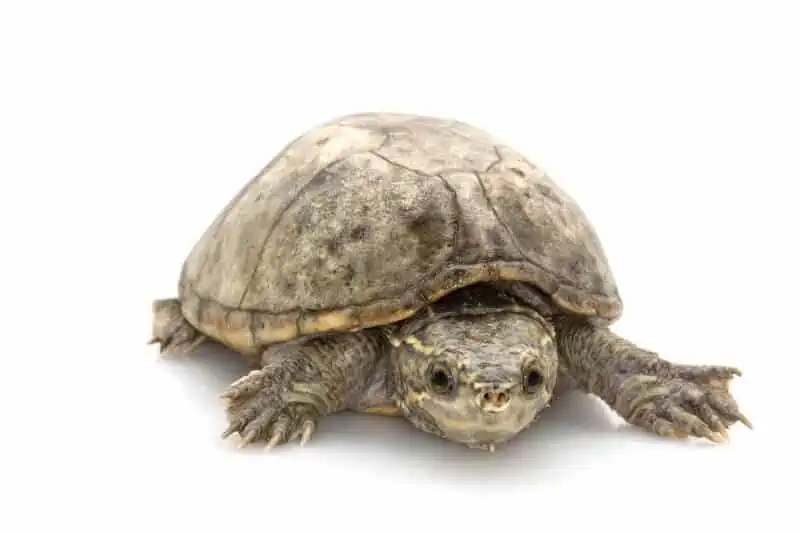
Their domed shells can be brown, gray or black, and they have two prominent stripes that run from nose to neck.
When dealing with a common musk turtle, it’s very important to handle it and its enclosure with care. This is a great turtle that stays small, but it can carry salmonella (like many other aquatic turtles), so wearing gloves to handle them or clean the tank is highly recommended. Wash your hands thoroughly when you’re done as well.
The common musk turtle isn’t a lover of deep water. In fact, it’s important to make sure that the water in the tank is shallow enough for the turtle to be able to touch the bottom and have its head out of the water at the same time. Keep the water in the tank between 75 and 82 degrees Fahrenheit.
A substrate is not necessary for this small turtle, but if you enjoy the look of a substrate, then it’s fine to add some gravel. However, since your turtle may choke if it accidentally swallows a piece of the gravel, it’s important to make sure that the pieces in the substrate are too big to be swallowed. Basking rocks and natural or artificial aquatic plants are excellent tank enhancements.
Like most other pet turtles, the common musk turtle requires supplemental UVB lighting and a heated basking area.
What do these guys like to eat? Your common musk turtle will do very well on a diet of turtle pellets, leafy greens, and the occasional protein items such as worms, crickets and dried shrimp. Don’t overfeed your common musk turtle, and you’ll need to remove any food that’s not eaten right away.
- Average Size: 3-4 inches
- Tank Size: 20-30 gallon tank
- Average Lifespan: 40-60 years
8. Ornate Box Turtle
This list of turtles that stay small is full of beginner-friendly species, but this isn’t one of them. They may bite if they feel threatened, they don’t like being handled, and they have some pretty specific and advanced care requirements.
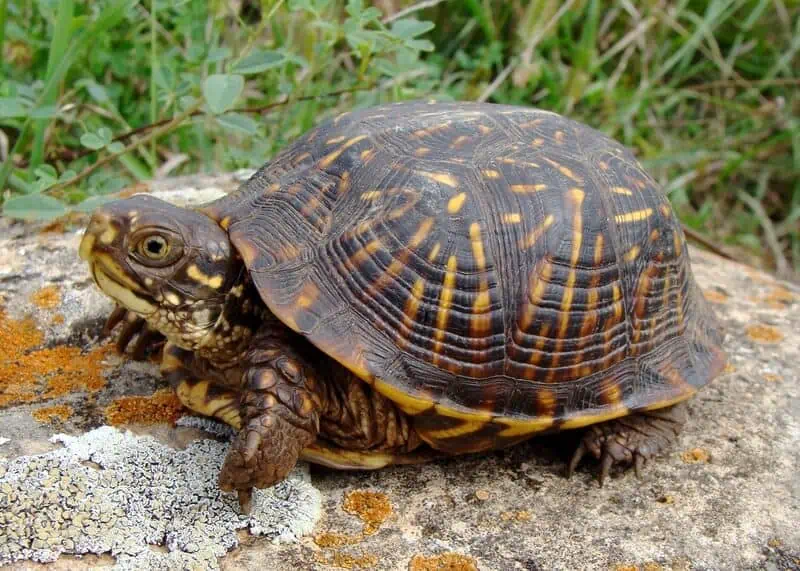
These beautifully patterned turtles are native to the grassland areas of Kansas, Nebraska, Iowa and Indiana. Turtle enthusiasts love this terrestrial turtle for its domed and brightly patterned shell. Its brown or gray body is also splashed with a lively pattern of yellow stripes and sunburst splotches.
The ornate box turtle can be housed outdoors or indoors, but it really does prefer to be outside. Wherever you decide to place its enclosure, make sure that it has a tightly fitting lid because this little turtle can be a bit of an escape artist.
The enclosure should have a nice, thick substrate of turtle-grass, soil, cypress mulch and moss. For your turtle to feel totally at home, it’s nice to add enhancements like rocks, logs, turtle hides and pieces of wood. For outdoor turtles, bury the walls of the enclosure to prevent them from burrowing under and escaping.
Outdoor turtles get heat and UVB light from the sun, but indoor turtles will require supplemental UVB light and heat.
Both indoor and outdoor ornate box turtles will need a constant supply of clean water. A bowl that’s cleaned daily is fine to use. As far as their diet goes, they can be given things like gut-loaded crickets, worms, grasshoppers, mealworms, canned cat food, hard boiled eggs, fruit and greens.
- Average Size: 5-7 inches
- Tank Size: 50 gallon tank
- Average Lifespan: 37 years
9. Map Turtle
Since female map turtles grow to be much larger than males, we will be only talking about male map turtles here (males stay quite small).
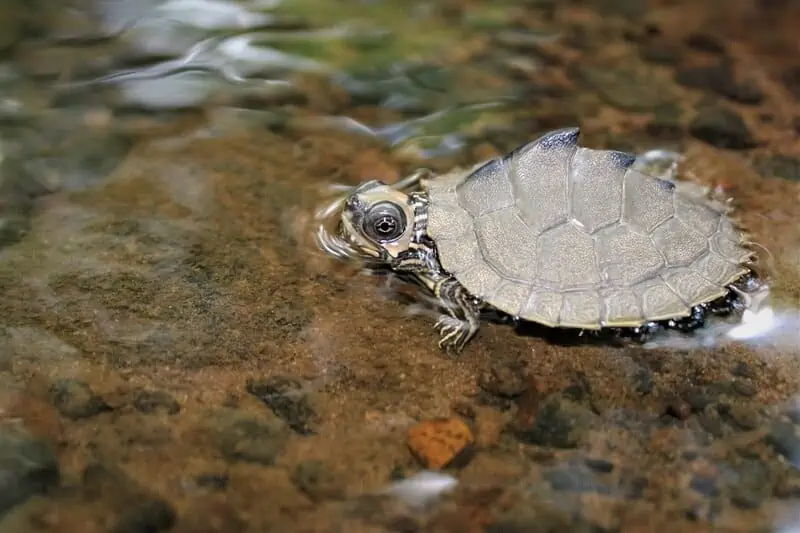
This lovely turtle gets its name from its skin pattern that resembles the contour markings on a map. Black ridges on an olive green to brown shell make this sweet turtle quite unique.
The map turtle is native to North America and can be found in deltas around the Mississippi River. There are several subspecies that include the Northern map turtle, the Mississippi map turtle and the Ouachita map turtle.
These aquatic cuties need a large tank, so they can swim and explore. Make sure, however, to add some pieces of driftwood for climbing and basking. A special basking platform can be used as well. Artificial or natural aquatic plants and a turtle hide are nice tank additions.
In terms of water for the tank, a good rule of thumb is to use 10-15 gallons of clean, filtered water per inch of the turtle. That’s why these little turtle pets are so convenient, you don’t need a very large tank! A UVB lamp and a heating element will be needed as well.
Map turtles are very happy with a diet of turtle pellets, greens like lettuce, kale, collards, dandelion greens, and sources of protein such as crickets, roaches, dried shrimp and mollies.
We think that this turtle’s docile nature and fairly easy care requirements make this a nice turtle for complete beginners.
- Average Size: Males: 3.5-6 inches, Females: 12 inches
- Tank Size: 55-75 gallon tank
- Average Lifespan: 30-50 years
10. Florida Softshell Turtle
Found in streams, marshes and ponds throughout Florida and parts of Georgia and South Carolina, the Florida softshell turtle is a common part of Florida scenery. This turtle is protected in the state of Florida, and it’s illegal to transport or sell them. Before you decide to take care of one of these turtles, it’s important to make sure that it was born in captivity and not taken from the wild.
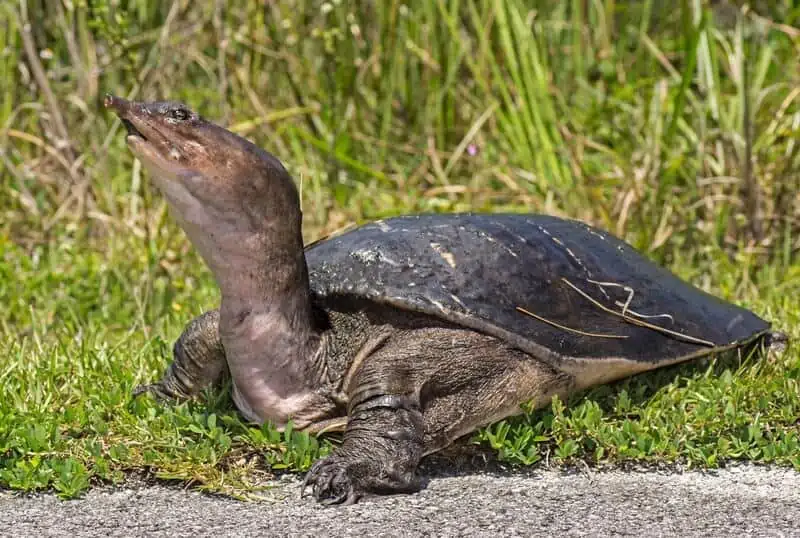
This turtle doesn’t have a typical, hard shell. Instead, the shell is made of a soft, leathery material. Female softshell turtles are much larger than males, so we will only be referring to males here.
The Florida softshell turtle needs a very large tank that’s filled deeply with fresh, clean water. These turtles like to burrow, so provide them with a gravel or sand substrate. Several areas where the turtle can bask are important, and large rocks work very well. We also suggest adding plenty of natural or artificial plants.
Turtle pellets aren’t going to cut it with a Florida softshell turtle. Worms, gut-loaded crickets, fish and even small frogs are more what this kind of turtle should be given.
- Average Size: Male: 6-12 inches Female: 8-24 inches
- Tank Size: 75-125 gallon tank
- Average Lifespan: 20-30 years
